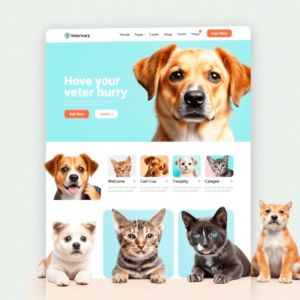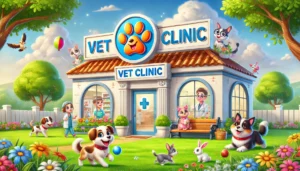Introduction
Creating an engaging veterinary practice newsletter is crucial for maintaining effective client communication. A well-crafted veterinary newsletter not only keeps pet owners informed but also strengthens their connection to your clinic. This regular touchpoint can significantly enhance client engagement by providing valuable insights, updates, and tips that cater to their needs.
Importance of newsletters for veterinary practices:
- Client Education: Newsletters serve as a platform to educate pet owners about various health topics, preventive care, and seasonal concerns.
- Clinic Updates: Share news about new services, staff additions, or changes in clinic hours.
- Promotional Opportunities: Highlight special offers, discounts on services, or upcoming events.
Enhancing client engagement through newsletters:
An engaging content strategy ensures that your newsletters are not just informative but also interesting and relevant. By consistently delivering content that resonates with pet owners, you build trust and foster lasting relationships.
10 tips for a successful veterinary newsletter:
We will explore 10 essential tips to help you craft newsletters that captivate your audience:
- Define Your Purpose and Audience
- Content Variety is Key
- Design and Branding Essentials
- Write in an Engaging Tone
- Enhance Visual Appeal
- Create a Scannable Format
- Personalization Matters
- Measure Success and Gather Feedback
- Consistency is Crucial
- Optimize Newsletter Length
Each tip offers practical advice aimed at making your veterinary newsletter a vital tool in client communication and engagement.
1. Define Your Purpose and Audience
Understanding your target audience is crucial for crafting a veterinary newsletter that resonates. Typically, this audience comprises pet owners and pet parents who are invested in the well-being of their furry companions. Knowing who you are writing for helps tailor content that addresses their specific needs and concerns.
Establishing the purpose of the newsletter is equally important. Determine whether your goal is to inform, promote services, or engage clients with updates and stories from your practice. A clear purpose guides content creation and ensures each edition adds value to your readers’ lives.
Setting a consistent publishing schedule enhances client engagement. Regular newsletters help build anticipation and trust, making them an expected part of your clients’ routine. Whether you choose a weekly, bi-weekly, or monthly schedule, consistency is key to maintaining reader interest and fostering ongoing communication.
2. Content Variety is Key
Diversifying content in your veterinary newsletter keeps readers engaged and encourages them to look forward to each edition. Content variety ensures that the information remains fresh and appealing.
1. Diverse Content Types
- Blogs: Share detailed pet care information, seasonal advice, or new treatments.
- FAQs: Address common concerns and questions from pet owners.
- Staff Spotlights: Introduce your team members, showcasing their expertise and personalities.
2. Engaging Topics
- Pet Health Tips: Provide actionable advice on nutrition, exercise, and preventive care.
- Clinic News: Update clients on new services, upcoming events, or changes in clinic hours.
Incorporating user-generated content fosters a sense of community. Encourage clients to share stories or photos of their pets, which can be featured in the newsletter. This not only enriches the content but also strengthens client relationships through active participation.
3. Design and Branding Essentials
Choosing a Professional Email Marketing Platform
Selecting the right email marketing platform is crucial for creating an engaging veterinary practice newsletter. Platforms like Mailchimp and Constant Contact offer user-friendly interfaces, advanced analytics, and customizable templates that can elevate your newsletter’s impact.
Utilizing Reusable Templates
Reusable templates save time while ensuring brand consistency. Customizable templates reflecting your practice’s branding—from logo placement to color schemes—enhance professional appearance and foster brand recognition.
Ensuring Design Clarity and Readability
Design clarity and readability are essential for effective communication. Use appropriate color schemes that align with your branding yet remain easy on the eyes. Clear fonts, ample white space, and well-structured layouts help in delivering your message without overwhelming the reader.
Incorporating these design and branding essentials will make your newsletters not only visually appealing but also consistent with your practice’s identity, ensuring a seamless reading experience for your audience.
4. Write in an Engaging Tone
A conversational writing style is essential for maintaining a friendly tone in your newsletters. Using simple, direct language helps clients feel more connected to your practice.
Creating relatability with clients involves choosing words and phrases that resonate with their experiences as pet owners. For instance, instead of saying “veterinary care,” use “caring for your furry family member.” This adds a personal touch to your client communication.
To avoid overly formal or dry language:
- Use contractions: “We’re” instead of “We are.”
- Ask questions: “Has your pet had their annual check-up yet?”
- Include anecdotes: Share a short story about a recent success in the clinic.
By focusing on these tips, you enhance the readability and engagement of your newsletters, ensuring clients look forward to each edition.
5. Enhance Visual Appeal
High-quality images play a crucial role in capturing reader attention and driving visual engagement. Using team photos instead of stock images can create a more personal connection with your audience. Clients appreciate seeing familiar faces and the behind-the-scenes activities at your clinic.
Best practices for using images effectively within newsletters:
- Relevance: Ensure that images are relevant to the content and add value to the message.
- Quality: Use high-resolution photos to maintain professionalism.
- Consistency: Align images with your branding, including color schemes and overall style.
Incorporate visuals that resonate with your brand’s messaging. For example, include photos of your staff interacting with pets, which can evoke positive emotions and strengthen client relationships. Remember, the right visuals are not just eye-catching but also serve to reinforce your practice’s identity and core values.
6. Create a Scannable Format
Crafting a newsletter that’s easy to navigate ensures your readers can quickly find the information they need.
Structuring Content:
- Use short paragraphs and clear subheadings to break up text.
- Introduce sections with scannable headlines for quick topic identification.
Bullet Points for Quick Reading:
- Bullet points allow readers to absorb key information swiftly.
- They help highlight crucial points without overwhelming the reader.
Incorporating Calls to Action (CTAs):
- Place CTAs strategically within your content.
- Encourage engagement by prompting specific actions, such as scheduling an appointment or visiting your website.
A well-organized layout transforms your veterinary newsletter into an engaging and accessible resource.
7. Personalization Matters
Personalization strategies can significantly enhance the effectiveness of your veterinary newsletter. Addressing emails with client and pet names fosters a sense of connection and attention to detail that resonates with readers.
Benefits of Personalizing Emails
- Increased Engagement: Personalized emails featuring client or pet names capture attention, making recipients more likely to open and read the content.
- Enhanced Loyalty: Demonstrating knowledge about clients and their pets builds trust and loyalty, encouraging repeat visits and long-term relationships.
Techniques for Collecting Data
- Client Forms: Use intake forms to gather essential information like pet names, birthdays, and health history.
- Surveys: Conduct periodic surveys to update client preferences and gather insights on their interests.
- Practice Management Software: Leverage software to track client interactions and preferences automatically.
Examples of Personalized Content
- Birthday Wishes: Send personalized birthday greetings to pets, perhaps including a special discount or treat.
- Health Reminders: Tailor reminders for vaccinations or check-ups based on individual pet health records.
- Exclusive Offers: Provide customized offers or recommendations based on specific client interests or pet needs.
Incorporating these personalization strategies creates a tailored experience that stands out, leading to a more engaged and loyal client base.
8. Measure Success and Gather Feedback
Tracking the performance of your veterinary newsletter is essential to ensure it meets its objectives. Key metrics to monitor include:
- Open Rates: Measure how many recipients open your newsletter. This indicates the effectiveness of your subject lines and overall interest.
- Click-Through Rates (CTR): Track how many readers click on links within the email. This shows engagement and interest in specific content.
Using practice management software or email marketing platforms like Mailchimp can simplify this process. These tools provide detailed analytics to help you understand what’s working and what needs improvement.
Collecting feedback from your subscribers is equally important. Encourage clients to share their thoughts through surveys or direct responses. Use this feedback to refine future newsletters, ensuring they remain relevant and engaging.
“Feedback is the breakfast of champions.” – Ken Blanchard
9. Consistency is Crucial
Maintaining a consistent publishing schedule is key to creating an engaging veterinary practice newsletter. Regularity builds anticipation and trust among your subscribers, who come to expect valuable updates at predictable intervals.
Establishing a Regular Schedule
- Weekly, bi-weekly, or monthly publications: Choose a frequency that aligns with your content creation capacity and audience preferences.
- Set clear expectations: Communicate the chosen schedule to your subscribers, ensuring they know when to expect the next issue.
Balancing Frequency
- Avoid overwhelming subscribers: Too many updates can lead to reader fatigue. Find a balance that keeps your clients informed without inundating their inboxes.
- Monitor engagement metrics: Track open rates and click-throughs to gauge if adjustments in frequency are needed.
For effective communication, consistency in the frequency of publication helps meet subscriber expectations while maintaining their interest and engagement.
10. Optimize Newsletter Length
Determining the ideal length of newsletters is crucial for maintaining reader interest. Aim for 20 lines of text per section, complemented by relevant graphics or videos. This balance ensures that information is digestible and visually appealing.
Key Points:
- Text Length: Keep each section concise, around 100-200 words.
- Graphics/Videos: Use visuals to break up text and enhance understanding.
- Prioritizing Information: Focus on essential content to maintain reader engagement.
By prioritizing key information, newsletters become more accessible and enjoyable for clients.
Conclusion
Implementing these tips for a successful veterinary newsletter can significantly enhance client engagement and build trust. By focusing on varied content, personalized touches, and consistent communication, you create newsletters that foster long-term relationships with clients.
Taking the time to craft an engaging veterinary practice newsletter not only keeps pet owners informed but also strengthens their connection to your practice. Embrace these strategies to offer valuable information and show your commitment to their pets’ well-being.
FAQs (Frequently Asked Questions)
What is the purpose of a veterinary practice newsletter?
The purpose of a veterinary practice newsletter is to enhance client communication by providing informative and promotional content that engages pet owners and strengthens their relationship with the practice.
How can I create engaging content for my veterinary newsletter?
To create engaging content, incorporate a variety of topics such as pet health tips, clinic news, staff spotlights, and user-generated content. This diversity will keep your audience interested and foster a sense of community.
What design elements should I consider for my newsletter?
When designing your newsletter, choose a professional email marketing platform and use reusable templates that reflect your branding. Ensure clarity and readability by selecting appropriate color schemes and fonts.
Why is personalization important in newsletters?
Personalization enhances the reader’s experience by making them feel valued. Using client and pet names in communications can significantly increase engagement, making the content more relatable and effective.
What metrics should I track to measure the success of my newsletter?
Key metrics to track include open rates and click-through rates. These metrics help assess how well your newsletters are performing and provide insights into areas for improvement.
How often should I send out my veterinary newsletter?
Establishing a regular publishing schedule is crucial to build anticipation among clients. However, it’s important to balance frequency to avoid overwhelming subscribers with too much information at once.









2 Responses
Thank you for this amazing post! The way you break things down makes it easy for anyone to grasp the key takeaways. Looking forward to more valuable content from you!
I really appreciate the effort you put into this post. The insights are valuable, and your writing style makes it so easy to understand. Looking forward to reading more from you!